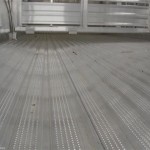Laminate Flooring on Basement Concrete: A Comprehensive Guide
Basements, often underutilized spaces, hold immense potential for transforming into functional areas. When considering flooring options for your basement, laminate flooring emerges as a compelling choice due to its durability, affordability, and aesthetic versatility. However, installing laminate flooring directly on a concrete basement floor requires careful consideration and preparation to ensure a successful outcome. This article delves into the intricacies of installing laminate flooring on basement concrete, providing a comprehensive guide for homeowners embarking on this project.
Understanding the Challenges of Basement Concrete
Basement concrete floors present unique challenges that require addressing before installing laminate flooring. These challenges stem from the concrete's inherent characteristics, which include:
- Moisture: Concrete is porous and susceptible to moisture intrusion, whether from ground seepage, humidity, or condensation. Excessive moisture can warp and damage laminate flooring.
- Unevenness: Concrete floors are rarely perfectly smooth and level. Unevenness can create gaps and instability in the laminate floor, leading to squeaks and movement.
- Temperature Fluctuations: Basements experience temperature variations, which can affect the expansion and contraction of laminate planks, potentially causing buckling and damage.
To mitigate these challenges, proper preparation is paramount. This involves addressing moisture issues, leveling the concrete surface, and creating a suitable subfloor that provides a stable and moisture-resistant base for the laminate flooring.
Preparing the Basement Concrete
Before installing laminate flooring, the basement concrete floor must be thoroughly prepared to ensure a successful and long-lasting installation. The preparation process encompasses several key steps:
1. Moisture Control:
Managing moisture is crucial to prevent damage to the laminate flooring. A moisture barrier, such as a 6-mil polyethylene sheet, should be laid over the clean concrete to prevent moisture from rising. If the basement has known moisture issues, consider installing a dehumidifier to regulate humidity levels.
2. Concrete Leveling:
Unevenness in the concrete floor can cause gaps and instability in the laminate flooring. Addressing this issue requires leveling the concrete surface. Several leveling methods exist, including self-leveling concrete, leveling compound, or thinset mortar. The chosen method should be appropriate for the degree of unevenness and the desired level of smoothness.
3. Subfloor Installation:
Once the concrete is leveled, a subfloor is installed to create a stable and moisture-resistant base for the laminate flooring. The subfloor material should be compatible with laminate flooring and provide a flat, even surface. Common options include:
- Plywood Subfloor: Plywood offers strength and stability and is a popular choice for subfloors.
- OSB Subfloor: Oriented strand board (OSB) is a cost-effective alternative to plywood, offering similar strength and stability.
- Underlayment: Underlayment acts as a moisture barrier and provides cushioning for the laminate flooring. It is typically installed over the subfloor.
Installing Laminate Flooring
With the basement concrete properly prepared, the laminate flooring can be installed. The installation process typically involves these steps:
1. Acclimate the Flooring:
Before installation, laminate flooring should be acclimated to the basement environment for at least 48 hours. This allows the planks to adjust to the temperature and humidity, minimizing warping and expansion issues.
2. Start Laying the Floor:
The first plank is typically laid against a wall, leaving an expansion gap around the perimeter of the room. This gap allows for the natural expansion and contraction of the flooring. Subsequent planks are interlocked, creating a seamless and secure floor.
3. Cut and Trim Planks:
As you work your way around the room, you may need to cut planks to fit around obstacles or corners. A circular saw or utility knife can be used for precise cuts.
4. Secure the Flooring:
Laminate flooring is typically held in place by a tongue-and-groove system. However, some manufacturers offer optional clips or adhesives for added security.
Remember to consult the laminate flooring manufacturer's installation instructions for specific recommendations and guidelines.

Laminate Flooring On Concrete Basement Floors Expert Installation Guide Csg Renovation

Laminate Flooring On Concrete Basement Floors Expert Installation Guide Csg Renovation

How To Install Vinyl Or Laminate Floors In A Basement Over Concrete Slab

Laminate Basement Flooring Over Concrete Majesty

Best Flooring For Basement Renovations

What Kind Of Flooring Should I Use To Finish My Basement Ozburn Hessey

The Best Flooring Options For Your Basement

Using Laminate Flooring For The Basement What To Know

Installing Laminate Flooring Over Concrete The Ultimate Guide Aa Floors

How To Install Laminate Flooring On Concrete Making Maanita
Related Posts








